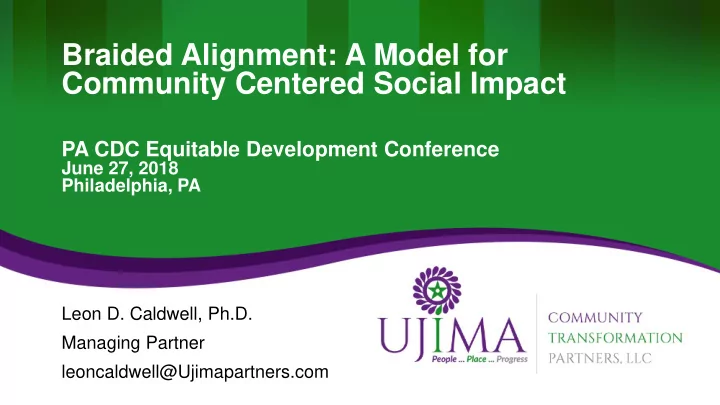

Braided Alignment: A Model for Community Centered Social Impact PA CDC Equitable Development Conference June 27, 2018 Philadelphia, PA Leon D. Caldwell, Ph.D. Managing Partner leoncaldwell@Ujimapartners.com
Purpose Driven Mission We are a purpose driven community centered social enterprise creating profitable investment opportunities with impactful real estate developments that transform neighborhoods into vibrant communities promoting economic mobility, wellness and health. Vision We envision healthy intergenerational communities that facilitate acquiring basic needs, spark innovation and are sustained with intentional investments in People first, then Place to ultimately promote Progress toward an equitable and just society.
The Built Environment Sustainable Healthy Communities Economic Health and Mobility Wellbeing Strategies Strategies
Development Concepts • Innovative strategies and buildings that sit at the intersection of public health and real estate development. • Creative concepts that solve social challenges. 4/27/2018 4
Ujima Community Centered Social Impact Process Pre- Braided Co-Design Solutions Sustainability Development Development Alignment
Defining Social Impact Community centered social impact utilizes a process of Braided Alignment to guide existing residents in defining social impact in their terms and then co-designs development projects sharing value with City officials, real estate developers, financial institutions and interested stakeholders.
The Challenge Equitable development requires a fair and just framework that provides input from a diverse set of community stakeholders. Some of the existing frameworks for community engagement exclude many residents from participating in creating solutions to neighborhood issues thereby mitigating the chances of promoting a sustainable healthy community. How might a CDC engage neighborhood residents and community stakeholders in creating sustainable solutions for the optimal health of a community?
Mis-Aligned Systems and Resources • Movement from various sectors of the community. • Public-private presence not partnership. • Lack of Strategic Communication • Perception of competition • Unclear boundaries • Unclear metric for outcome and performance
Alignment of Resources: Collective Impact • Awareness of general goals • Clear firm boundaries (Silos) • One-way Communication • Collaborative when necessary • Moving in consistent direction • Coordination of Backbone Organization
Distinction
Sustainable Innovation Five Strands for Alignment 1. Inclusion Alignment 2. Conceptual Alignment 3. Policy Alignment 4. Funding Alignment 5. Implementation Alignment
In Inclusion Activity 1: • Network Analysis • Who is at the table and what do they bring? • Who is not at the table? And Why?
Conceptuali lization Activity 2: • What’s the End in Mind? • Are you addressing the symptoms or root cause? • What are the innovation opportunities in your community? • Creating a common understanding of what needs to be solved and they ways it can solved. • The Fish and Water analogy.
Polic licy Activity 3: What system policies and practices promote your solutions? What policies and practices threaten your solutions?
Fundin ing Activity 4: How is going to get funded? What does blended funding look like in your community. What’s your ROI and ROC?
Im Imple lementation Activity 5: • Return to the network map. • Who has the capacity? • What capacities need to be invested? • “Six I Questions”
Sustaining the Braid Sustaining the braid requires acknowledging and accounting for the natural evolution of implementation. We consider the three following strategies: • Fraying – happens over time and is the natural wear and tear as system changes. To prevent fraying systems should invest in maintaining the braid with consistent authentic communication and celebration of collective efforts. • Kinking – is a result of moving too rapidly within the system. Removing a kink may require more deliberate attention to communication and attention to natural apprehension for change. Kinking requires gentle movement of the ecosystem. • Knotting – is a natural by-product of confronting an adaptive challenge with adaptive change. They should not be catastrophized. Knots require attention to understanding the nature of the blockage
Six “I” Questions for Community Implementation Purpose Question Inventory What do we have already? Investigation How well does it work? Interrogate For whom does it work? Inquiry What is missing? Iteration How do we implement? Insights Did we move the needle towards the desired results Confidential - Material contained in these slides is copywritten - Written consent required to duplicate any and all parts of this slide 18 6/26/2018 deck.
Why Is Community Engagement Essential to Equitable Development? • Affordable Housing Solution • Social Justice & Equity • Racial Wealth Divide • Public and Population Health • Graying of the City of • Fair Housing Philadelphia • Sanctuary City Status • Racial Housing Segregation
Neighborhoods Are Systems Searching for Communities
Dr. Leon D. Caldwell , Social Entrepreneur and Scholar-Activist • West Philadelphia born and raised • Real Estate portfolio includes multi-unit and commercial properties. • 20 years experience as an award winning Community-Based Researcher and Founder of community-centered translational research centers funded by universities and philanthropy. • Ph.D. in Counseling Psychology, Penn State • BA (Economics) and M.Ed. (School Counseling), Lehigh University • Associate Professorships of Educational Psychology, Social Work and African American Studies at major research universities. • International and domestic population and public health research experiences • Senior leader in national philanthropies and Fellow, Association of Black Foundation Executives • Growth Mindset - 15 years experience in real estate and social entrepreneurism
Phone: 215-839-6049 email: leoncaldwell@ujimapartners.com website: www.ujimaImpactDevelopers.com
Recommend
More recommend